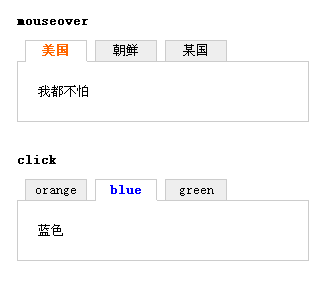JS實現完全語義化的網頁選項卡效果代碼
編輯:關於JavaScript
本文實例講述了JS實現完全語義化的網頁選項卡效果代碼。分享給大家供大家參考。具體如下:
這是一款完全語義化的JS網頁選項卡,包括了兩種用法,一種是點擊式,另一種是滑動門式,具體用哪一種要根據你自己的需要了,滑動門是在鼠標經過時觸發,選項卡則是需要鼠標點擊的。
運行效果截圖如下:

在線演示地址如下:
http://demo.jb51.net/js/2015/js-yyh-web-tab-cha-nav-codes/
具體代碼如下:
<!DOCTYPE html PUBLIC "-//W3C//DTD XHTML 1.0 Transitional//EN"
"http://www.w3.org/TR/xhtml1/DTD/xhtml1-transitional.dtd">
<html xmlns="http://www.w3.org/1999/xhtml">
<head>
<title>語義化的網頁選項卡</title>
<style type="text/css">
*{margin:0;padding:0;font-size:13px;line-height:1.5;}
body{padding:20px;}
.cur{color:#f60;border-bottom:1px solid #fff;font-weight:bold;background:#fff;cursor:default;}
#tab_,dl{position:relative;float:left;height:100px;width:300px;}
h4,dt{float:left;height:20px;margin:0 0 0 8px;display:inline;line-height:20px;width:60px;border:1px solid #ccc;position:relative;z-index:11;text-align:center;font-weight:normal;cursor:pointer;background:#eee;}
.c,dd{position:absolute;top:21px;border:1px solid #ccc;left:0;width:250px;padding:20px;overflow:hidden;display:block;}
#tab_{clear:left;}
h1{clear:left;padding:10px 0}
#tab_1.cur{color:#f60}
#tab_2.cur{color:blue}
#tab_3.cur{color:green}
</style>
</head>
<body>
<h1>mouseover</h1>
<dl id="tab">
<dt>美國</dt>
<dd>我都不怕</dd>
<dt>朝鮮</dt>
<dd>誰都怕我</dd>
<dt>某國</dt>
<dd>我誰都怕</dd>
</dl>
<h1>click</h1>
<div id="tab_">
<h4>orange</h4>
<div class="c">桔紅</div>
<h4>blue</h4>
<div class="c">藍色</div>
<h4>green</h4>
<div class="c">綠色</div>
</div>
<script type="text/javascript">
function id(elem) {return document.getElementById(elem)}
function show(elem) {elem.style.display = "";}
function hide(elem) {elem.style.display = "none";}
function next( elem ) {
do {
elem = elem.nextSibling;
} while ( elem && elem.nodeType != 1 );
return elem;
}
function tab(a, p) {
var p = (p === undefined) ? {e:"onclick",n:1} : p,
node = id(a).firstChild,
x = [];
p.e = (p.e === undefined) ? "onclick" : p.e;
p.n = (p.n === undefined) ? 1 : p.n;
node=(node.nodeType !== 1)?next(node):node;
for (var i = 1, node; node; i++, node = next(node)) {
x[i] = node;
}
for (var i = 1; x[i]; i++) {
if(i % 2 == 0){hide(x[i]);x[i-1].id=a+(i/2)}
x[p.n*2-1].className = "cur";
show(x[p.n*2]);
temp = function (i) {
if (i % 2 == 1) {
x[i][p.e] = function () {
for (var j = 1; x[j]; j++) {
if (j % 2 == 0) {
hide(x[j]);
x[j-1].className = ""
}
}
show(x[i+1]);
x[i].className = "cur"
}
} else {
return null
}
}(i)
}
}
tab("tab",{e:"onmouseover",n:2});
tab("tab_")
</script>
</body>
</html>
希望本文所述對大家的JavaScript程序設計有所幫助。
小編推薦
熱門推薦